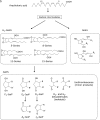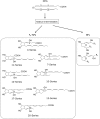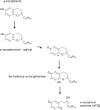The role of lipid peroxidation in neurological disorders
- PMID: 24895477
- PMCID: PMC4042144
- DOI: 10.3164/jcbn.14-10
The role of lipid peroxidation in neurological disorders
Abstract
There has been much evidence demonstrating the involvement of oxidative stress in the pathology of neurological disorders. Moreover, the vulnerability of the central nervous system to reactive oxygen species mediated injury is well established since neurons consume large amounts of oxygen, the brain has many areas containing high iron content, and neuronal mitochondria generate large amounts of hydrogen peroxide. Furthermore, neuronal membranes are rich in polyunsaturated fatty acids, which are particularly susceptible to oxidative stress. Recently, the biological roles of products produced by lipid peroxidation have received much attention, not only for their pathological mechanisms associated with neurological disorders, but also for their practical clinical applications as biomarkers. Here, we discuss the production mechanisms of reactive oxygen species in some neurological disorders, including Alzheimer's disease, Down syndrome, Parkinson's disease, and stroke. We also describe lipid peroxidation biomarkers for evaluating oxidative stress.
Keywords: Alzheimer’s disease; Down syndrome; Parkinson’s disease; lipid peroxidation; neurological disorder; stroke.
Figures







References
-
- Sies H. Oxidative stress: oxidants and antioxidants. Exp physiol. 1997;82:291–295. - PubMed
-
- Miyamoto S, Kawano H, Hokamaki J, et al. Increased plasma levels of thioredoxin in patients with glucose intolerance. Intern Med. 2005;44:1127–1132. - PubMed
-
- Cracowski JL. Isoprostanes: an emerging role in vascular physiology and disease? Chem Phys Lipids. 2004;128:75–83. - PubMed
-
- Halliwell B. Oxidative stress and neurodegeneration: where are we now? J Neurochem. 2006;97:1634–1658. - PubMed
-
- Harman D. Aging: a theory based on free radical and radiation chemistry. J Gerontol. 1956;11:298–300. - PubMed
Publication types
LinkOut - more resources
Full Text Sources
Other Literature Sources

